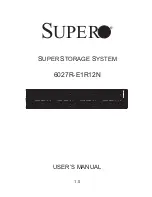
manufacturer. If you are installing a full-length adapter, you might have to
remove a plastic bracket secured to the adapter with 2 screws before
installing the adapter.
Attention:
When you install an adapter, ensure that the adapter is
correctly seated in the connector before you turn on the server. Improperly
seated adapters might cause damage to the system board, the riser card
for slot 1, or the adapter.
b. Grasp the adapter by its top edge or upper corners, align it with the
connector, and press it
firmly
into the connector.
9. Slide the expansion-slot clip toward the server until it snaps into place to
secure the adapter in the adapter slot.
10. Connect any internal cables to the adapter. See the instructions that come with
the adapter for details.
Attention:
Ensure that the cables do not block the flow of air from the fans.
11. If you removed the power-cord module to install the adapter in PCI-X slot 1,
install the module by reversing the procedure in step 7a on page 15. Ensure
that the alignment tab is fully seated in the slot on the side of the server.
12. If you installed the adapter in PCI-X slot 2, secure the adapter by flexing the
adapter-retention bracket toward the front of the server and inserting the front
corners of the adapter into the recesses in the latch.
13. Perform any configuration tasks required for the adapter.
Note:
If you installed a Remote Supervisor Adapter:
a. Refer to the documentation provided with the Remote Supervisor
Adapter for information about installing the Remote Supervisor
Adapter firmware and configuring the adapter.
b. After you initially configure the adapter, you should create a backup
copy of it so that if you need to replace the adapter in the future,
you can restore the configuration and resume normal operation
more quickly.
14. If you have other options to install, install them now. Otherwise, go to
“Completing the installation” on page 27.
Working with a hard disk drive
This section describes how to install a hard disk drive in the server. Before you
install a hard disk drive, review the following information:
v
The server supports two 25.4-mm (1-inch), slim, 3.5-inch hard disk drives. SCSI
models of the server come with a hot-swap SCSI backplane.
v
The
™
SCSI server models support low voltage differential (LVD) hot-swap drives.
Each hot-swap drive resides in a tray, which has a green activity LED and an
amber status LED in the upper-right corner. These LEDs are lit if the drive is
active and, in some cases, if the drive fails. Each hot-swap drive has a
single-connector-attached (SCA) connector, which plugs directly into the
hot-swap SCSI backplane. The backplane attaches to connector J18 on the
system board and controls the SCSI IDs for the hot-swap drives.
v
Non-hot-swap disk drives do not require a backplane or tray and they do not
have indicator LEDs. However, you must attach the blue rails that come with the
drive before installing it in the server.
v
Non-hot-swap disk drives have a jumper block on the rear. Install a jumper in the
cable-selection position of the jumper block. For details, see the notes under step
4 on page 18, and the documentation that comes with the drive.
16
IBM xSeries 335 Type 8676: Option Installation Guide
Содержание xSeries 335
Страница 1: ...IBM xSeries 335 Type 8676 Option Installation Guide ERserver...
Страница 2: ......
Страница 3: ...IBM xSeries 335 Type 8676 Option Installation Guide ERserver...
Страница 20: ...10 IBM xSeries 335 Type 8676 Option Installation Guide...
Страница 46: ...36 IBM xSeries 335 Type 8676 Option Installation Guide...
Страница 50: ...40 IBM xSeries 335 Type 8676 Option Installation Guide...
Страница 59: ......
Страница 60: ...Part Number 48P9909 Printed in U S A 1P P N 48P9909...














































